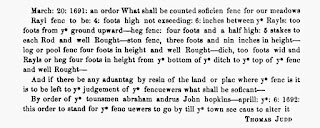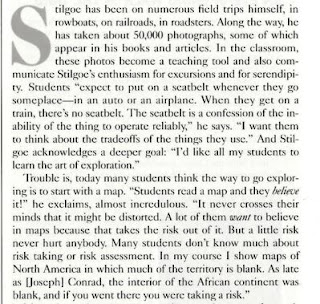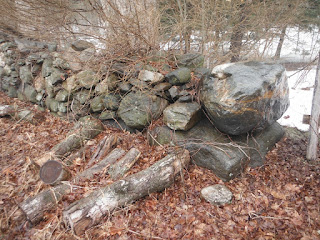“From Coventry comes the Legend
of Carbuncle Pond. Years ago when that particular region was claimed
by Narragansett and Mohegan alike, there lived on Carbuncle Hill a great snake. Its species was unknown,
but its size was enormous and in the center of its head was a large gem — a
carbuncle deep red, glowing with the brilliancy and radiance of a great fire.
Whenever it moved about at night, its coming was announced by the glow of the gem,
and even by day its light could be seen in a crimson flood in the darkness of
the woods. Efforts of the Indians to capture the snake were unsuccessful until,
shortly before the coming of the first white men, a large party of Indians
surprised the reptile, and after a terrific battle killed it and secured the
carbuncle. Tradition relates that at the scene of the battle a large rock was
cleft in twain by the snake's tail. The carbuncle served the Indian tribe as a
talisman and warning of danger for many years. When the white men came and
heard the story of this wonderful gem, they longed to possess it and arranged
an expedition against the Indians for that purpose. They attempted a surprise
attack, but their advance was announced by the increased glow of the stone, and
the Indians were prepared. After a battle which decimated the Indians, the
chief alone was left standing; but when the white men tried to take the
carbuncle from him he drew back his arm and gave it a mighty throw. It landed
with a great splash in the middle of the pond and was lost forever.”
- Workers of the Federal Writers' Program of the Works Progress Administration for the State of Rhode Island, Rhode Island: A Guide to the Smallest State, American Guide Series, Riverside Press, Cambridge, Houghton Mifflin Company, Boston, 1937.
Rhode Island Folklore thesis 1956
“Snakes, too, had a certain magic charm. Near the Connecticut line in what is now Coventry, a great snake once lived on Carbuncle Hill. Its species was unknown, but its size was enormous, and in the center of its head was a large gem--a carbuncle--deep red, glowing with the brilliancy and radiance of a great fire. Wherever it went at night, its presence was always announced by the glow of the gem, and even ln the daytime the light from the carbuncle could be seen in a crimson flood in the darkness of the woods. The Narragansetts and Mohegans, who had a mutual claim on this territory, tried to capture the great snake, but all efforts were unsuccessful until shortly before the coming of the first white man. A large party of Indians managed to surround the reptile and kill it; during the terrific battle, the snake cut a huge rock in two with one swipe of his tail. The carbuncle became the treasured talisman of the Indian tribe, and it served as a warning of danger for many years. When the white man carne and heard the s tory of this wonderful gem, they wanted to have it and arranged an expedition against the Indians to take it away. Since the settler's surprise attack was announced by the increased g low of the stone, the Indians were prepared. After the long, bitter battle, all the Indians were killed except the chief who stood alone with the carbuncle. When the white men tried to take the gem away from him, he drew back his arm and gave it a mighty throw. It landed with a great splash in the middle of a pond and was lost forever. Today that small lake is known as Carbuncle Pond.” Pages 91-92
https://digitalcommons.uri.edu/cgi/viewcontent.cgi?article=1916&context=theses
Mooney writes, "Those who know say that the Uktena is a great snake, as
large around as a tree trunk, with horns on his head, and a bright, blazing
crest like a diamond upon its forehead, and scales glittering like sparks of
fire. It has rings or spots of color along its whole length, and can not be wounded
except by shooting in the seventh spot from the head, because under this spot
are its heart and its life. The blazing diamond is called Ulunsuti,
"Transparent", and he who can win it may become the greatest wonder
worker of the tribe, but it is worth a man's life to attempt it, for whoever is
seen by the Uktena is so dazed by the bright light that he runs toward the
snake instead of trying to escape.
Of all the daring warriors who have started out in search of the Ulunsuti only Aganunitsi ever came back successful. The East Cherokee still keep the one which he brought. It is like a large transparent crystal, nearly the shape of a cartridge bullet, with a blood-red streak running through the center from top to bottom.. The owner keeps it wrapped in a whole deerskin, inside an earthen har hidden away in a secret cave in the mountains. Every seven days he feeds it with the blood of small game, rubbing the blood all over the crystal as soon as the animal has been killed. Twice a year it must have the blood of a deer or some other large animal. Should he forget to feed it at the proper time it would come out from its cave at night in a shape of fire and fly through the air to slake its thirst with the lifeblood of the conjurer or some one of his people. He may save himself from this danger by telling it, when he puts it away, the he will not need it again for a long time. It will then go quietly to sleep and feel no hunger until it is again brought out to be consulted. Then it must be fed again with blood before it is used.
http://www.nativehistoryassociation.org/uktena_ulunsuti.php
“…the snake cut a huge rock in two with one swipe of his tail.”

















































